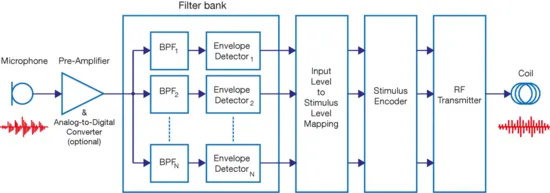Introduction to Cochlear Implants
Cochlear implants (CI) are electrical neural prostheses that are designed to restore functional hearing to individuals suffering from severe to profound deafness. CI systems comprise two main components: an externally worn sound processor with a microphone and radio-frequency (RF) transmission system, and an internally implanted electrode array with an RF receiver. Incoming acoustic signals are converted by the external sound processor to electrical stimulation patterns that are delivered as current pulses by the implanted electrode array and stimulate the auditory nerve. The nerve’s response pattern is interpreted by the brain as sound. CI systems bypass the physiological structures preceding the auditory nerve and are prescribed to individuals with hearing loss too severe to be aided by sound amplification in hearing aids. Since CIs communicate directly with the central nervous system, it is vital that the electrical stimulation patterns output by the electrode array accurately encode sound information in a way that can be interpreted by the brain. Therefore, the ‘sound coding strategy’ employed by the sound processor to convert acoustic signals to electrical stimulation patterns is a key determinant of listening outcomes in CI users.
The block diagram for an implementation of the widely used ‘Continuous Interleaved Sampling’ (CIS) sound coding strategy (Wilson et al., 1991) is shown in Figure 1. Our work is geared towards designing novel sound coding strategies which is interlinked with our research on auditory models.

Figure 1: System block diagram for the implementation of a CIS sound coding strategy. In this strategy, an audio input signal from the microphone is amplified, pre-emphasis filtered, and passed through an automatic gain control function. The signal is then split into multiple frequency channels via a bank of band-pass filters, with each channel corresponding to a specific intra-cochlea electrode. The temporal envelopes of the filter outputs are then extracted, and their amplitudes mapped to the electrical dynamic range associated with the corresponding electrode. Following amplitude mapping, the envelope signal within each selected channel is used to amplitude modulate fixed-rate pulse trains that are transmitted to the corresponding intra-cochlea electrode via the RF transmission link.
CI recipients can often achieve good speech comprehension in favorable listening conditions but typically face challenges when listening in noisy or reverberant spaces. One reason for this are limitations in the way current sound coding strategies transmit spectral and temporal information that normally act as vital ‘cues’ to help the brain perform auditory scene analysis to hear out a sound of interest from a complex sound mixture. One such set of cues arise from differences between the signals arriving at the two ears with respect to arrival-time (interaural time difference; ITD) and level (interaural level difference; ILD). Of these ‘binaural’ cues, bilateral CI users typically exhibit poor sensitivity to ITD cues and thus miss out on the benefits they would otherwise provide (Seeber and Fastl, 2008).
Our work
The broad objectives of our work on cochlear implants are to investigate factors that limit the brain’s ability to hear out one sound in the presence of other sounds and to develop novel sound coding strategies and intelligent pre-processing algorithms that alleviate those factors. We focus on understanding what prevents bilateral implant users from achieving the full potential offered by binaural hearing and we aim to improve the coding of binaural information. One such algorithm we are a currently developing is an ‘onset enhancement’ algorithm that aims to improve the sensitivity of bilateral CI users to ITDs in reverberant or noisy conditions. The algorithm selectively enhances onsets in the slow-varying temporal envelope of a signal, with the goal of emphasizing the ITD information. To optimize the way the algorithm encodes ITDs, we are also investigating how to most reliably identify ITD information related to a desired sound source from the signals received by devices at the two ears.
Results from currently ongoing evaluations of the onset enhancement algorithm with bilateral CI users, and previous assessments with unimpaired individuals listening through vocoders to simulate CI listening, all suggest that the algorithm can significantly improve sensitivity to ITDs in speech signals under reverberant conditions (simulated using virtual acoustics). For the evaluations with bilateral CI users, the algorithm is implemented and tested using direct stimulation research platforms. Future developments of the algorithm aim to improve speech understanding outcomes in multi-source environments.
This study is supported by BMBF 01 GQ 1004B.
Team Members involved in CI research
Current:
Bernhard Seeber
Past:
Aswin Wijetillake
Marko Takanen
Jessica Monaghan
Claudia Freigang
Stefan Kerber
Robert Pierzycki
Colin Horne
Selected Publications
Kerber, S.; Seeber, B.: "Localization in reverberation with cochlear implants: predicting performance from basic psychophysical measures". Journal of the Association for Research in Otolaryngology, 14, 379-392, 2013.
Kerber, S.; Seeber, B.: "Sound Localization in Noise by Normal-Hearing Listeners and Cochlear Implant Users". Ear and Hearing, 33, 445-457, 2012.
Horne, C.; Sumner, C.S.; Seeber, B.U.: "A phenomenological model of the electrically stimulated auditory nerve fiber: temporal and biphasic response properties". Frontiers in Computational Neuroscience, 10(8), 2016.
Seeber, B.; Fastl, H.: "Localization cues with bilateral cochlear implants". J. Acoust. Soc. Am., 123(2), 1030-1042, 2008.
Seeber, B.; Baumann, U.; Fastl, H.: "Localization ability with bimodal hearing aids and bilateral cochlear implants". J. Acoust. Soc. Am., 116 (3), 1698-1709, 2004.
Pierzycki, R.H.; Seeber, B.U.: "Comodulation masking release in electric hearing". J. Assoc. Res. Otolaryngol., 15(2), 279-291, 2014.
Wijetillake, A.; Seeber, B.U.: "Improving ITD Based Source Localization for Bilateral CI Users in Reverberant Conditions Using a Novel Onset Enhancement Algorithm". Conference of Implantable Auditory Prostheses, Lake Tahoe, CA, USA, 176, 2015.
References:
Wilson, B.S.; Finley, C.C.; Lawson, D.T.; Wolford, R.D.; Eddington, D.K.; Rabinowitz, W.M.: "Better speech recognition with cochlear implants". Nature, 352, 236-238, 1991.